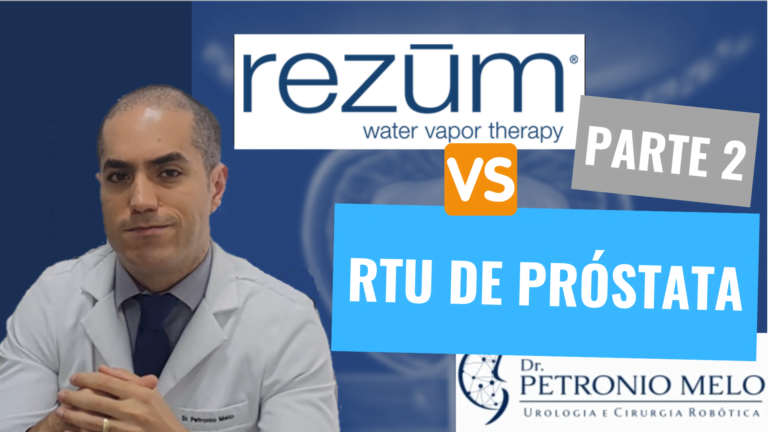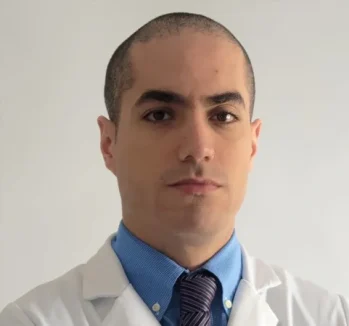Index
Rezum vs. RTU of the prostate – Part 2: In this second article on this topic, we will discuss and compare the preparation, procedure duration, efficacy, recovery time, and conclude which is the best procedure for benign prostatic hyperplasia (BPH).
How to Prepare for Rezum Treatment?
The Rezum treatment is a minimally invasive and relatively new option for the treatment of benign prostatic hyperplasia (BPH). If you’re considering Rezum treatment, it’s vital to be prepared before the procedure to ensure everything goes as smoothly as possible. Here are some steps you can take to prepare for the Rezum treatment:
Discuss your medications with your doctor
Before the Rezum treatment, it’s essential to discuss all the medications you’re taking with your doctor, including prescriptions, over-the-counter drugs, and supplements. Some drugs, like blood thinners, might need to be discontinued before the procedure to reduce bleeding risk.
Undergo a physical examination
Before the Rezum treatment, your doctor may advise a comprehensive physical examination to assess your overall health and ensure you’re fit for the procedure. This might include a prostate check and urine tests to see if there’s an infection or other medical conditions.
Quit smoking and avoid alcohol
If you smoke, it’s advised to quit at least two weeks before the Rezum treatment. Smoking can increase the risk of complications during the procedure and recovery. Also, it’s recommended to refrain from alcohol consumption before the procedure, as it can affect anesthesia and heighten the bleeding risk.
Undergo imaging tests
Before the Rezum treatment, your doctor might request imaging tests like ultrasound or MRI to assess the prostate’s size and shape. This helps in determining the best approach for treatment and ensures Rezum is the right choice for you.
Follow your doctor’s instructions
Before the Rezum treatment, your doctor will provide specific guidelines on how to prepare for the procedure. It’s crucial to follow these directions closely to ensure everything goes smoothly. This might include avoiding food and drink for a certain period before the procedure, taking prescribed medications, and arranging for someone to drive you home afterward.
Prepare for recovery
Post-Rezum treatment, it’s normal to experience some discomfort and symptoms like frequent or urgent urination, which might last a few days. Your doctor will provide specific guidance on how to care for yourself during recovery, including resting, limited physical activity, and other care. Following these instructions closely is essential for a calm and full recovery.
In summary, if you’re prepping for Rezum treatment, it’s essential to discuss your medications with your doctor, undergo a physical exam, quit smoking and avoid alcohol, get imaging tests done, heed your doctor’s guidelines, and gear up for recovery. Talk about any uncertainties or concerns with your physician before the procedure to ensure you’re comfortable and confident in the process. Rezum can be an effective and safe option for BPH treatment, and adequate preparation can aid in a smooth and successful recovery.
Remember, specific instructions for Rezum treatment may differ based on your doctor and individual health conditions. It’s crucial to follow the guidance given by your physician and discuss any questions or concerns with them.
Moreover, if you’re on any prescription or over-the-counter medication, it’s vital to discuss with your doctor whether you need to discontinue them before the Rezum procedure. Some drugs, like blood thinners, might need to be stopped to reduce the risk of bleeding during the procedure.
Lastly, ensure you have someone to take you home post-Rezum procedure, as it might not be safe to drive alone. Discuss with your doctor if you need to make these arrangements ahead of the procedure.
By following these guidelines, you’ll be set for Rezum treatment and can look forward to a smooth and successful recovery.
How to Prepare for TURP (Transurethral Resection of the Prostate)?
TURP is a common surgical procedure for the treatment of benign prostatic hyperplasia (BPH). If you are gearing up for TURP, it’s essential to be well-informed and ready for the procedure. Here are some steps you can take to prepare:
Discuss your medications with your doctor
Before TURP, it’s crucial to discuss all the medications you’re taking with your doctor, including prescriptions, over-the-counter drugs, and supplements. Some drugs, like blood thinners, might need to be discontinued before the procedure to reduce the risk of bleeding.
Undergo a physical examination
Before TURP, your doctor may recommend a comprehensive physical examination to assess your overall health and ensure you’re fit for the procedure. This could include a prostate check and urine tests to detect infections or other medical conditions.
Undergo imaging tests
Before TURP, your doctor might request imaging tests, such as ultrasound or MRI, to evaluate the prostate’s size and shape. This aids in determining the best approach for treatment and ensures TURP is the optimal choice for you.
Follow your doctor’s instructions
Before TURP, your doctor will provide specific guidelines on how to prepare for the procedure. It’s vital to heed these instructions closely to ensure everything runs smoothly. This could involve avoiding food and drink for a certain period before the procedure, taking prescribed medications, and arranging for someone to drive you home afterward.
Prepare for recovery
Post-TURP, it’s typical to experience some discomfort and symptoms like blood in the urine, which might last for a few days. Your doctor will provide specific guidance on how to care for yourself during the recovery, encompassing resting, limited physical activity, and other necessary care. Adhering to these instructions is vital to ensure a smooth and thorough recovery.
In conclusion, if you’re gearing up for TURP, it’s crucial to discuss your medications with your doctor, have a physical examination, undergo imaging tests, heed your doctor’s guidelines, and gear up for the recovery phase. Address all your questions and concerns with your doctor before the procedure to ensure you’re comfortable and confident with the process.
Remember, the specific instructions for TURP might differ based on your doctor and individual health conditions. It’s essential to follow the guidance given by your physician and discuss any doubts or concerns with them.
Furthermore, ensure you have someone to drive you home post-TURP as it might not be safe to drive alone. Discuss with your doctor if you need to make such arrangements ahead of the procedure.
By following these guidelines, you’ll be well-prepared for TURP and can anticipate a smooth and successful recovery.
Rezum vs. TURP: What is the Procedure Duration?
The duration of the procedure is a primary concern for many men considering treatment for benign prostatic hyperplasia (BPH). Both Rezum treatment and transurethral resection of the prostate (TURP) are common options for treating BPH, but which procedure is faster and more efficient? Here’s what you need to know about the duration of these procedures:
Rezum
The Rezum procedure is a minimally invasive treatment typically performed in a medical office or surgical center under local anesthesia. The procedure’s duration varies, but it generally takes about 10 to 15 minutes. During the procedure, the doctor inserts a small instrument into the urethra to administer water vapor therapy into the prostate. Patients typically can return home the same day of the procedure, and recovery may take from a few days to several weeks.
TURP
TURP is a surgical procedure typically conducted in a hospital or surgical center under general or regional anesthesia. The duration of the procedure can vary but generally takes from one to two hours. During the procedure, the doctor uses an instrument called a resectoscope to remove excess prostate tissue through the urethra. Patients usually need to stay in the hospital for a few days post-procedure, and recovery can range from several weeks to a few months.
Comparison
In terms of duration, Rezum treatment is generally faster and less invasive than TURP. Rezum can be performed in a medical office rather than a hospital, and the procedure’s duration is typically significantly shorter. However, it’s important to remember that every case is unique, and the procedure’s duration might differ based on the severity of BPH and the technique used by the doctor.
In conclusion, the procedure duration is a significant concern for many men considering treatment for BPH. While TURP is a more invasive and longer procedure, it might be necessary for more severe cases. Rezum treatment is usually quicker and less invasive, but the duration can differ based on the individual case. It’s crucial to discuss your options with a trusted doctor to determine which treatment is best for you.
Comparing the Efficacy of Rezum to TURP
Efficacy is an important factor in choosing treatment for benign prostatic hyperplasia (BPH). Both Rezum treatment and transurethral resection of the prostate (TURP) are common options for treating BPH, but which procedure is more effective? Here’s what you need to know about the efficacy of these procedures:
Rezum
The Rezum procedure is a relatively new treatment option for BPH and has been shown to be effective in several clinical studies. During the procedure, the doctor inserts a small instrument into the urethra to administer water vapor therapy into the prostate. The water vapor heats and destroys excess prostate tissue, thus reducing urinary obstruction and the symptoms associated with BPH.
In a recent clinical study comparing Rezum to TURP, results showed that patients treated with Rezum had significant improvement in urinary symptoms compared to patients treated with TURP. Moreover, the study revealed that Rezum was associated with fewer complications and side effects than TURP.
TURP
TURP is a more traditional treatment option for BPH and has been widely used for decades. During the procedure, the doctor uses an instrument called a resectoscope to remove excess prostate tissue through the urethra. TURP has proven to be an effective treatment option for BPH and has a relatively high success rate.
However, TURP can also be associated with complications and side effects, including bleeding, infection, urinary incontinence, and erectile dysfunction. Additionally, TURP is more invasive than Rezum and requires a longer recovery time.
Comparison
In terms of efficacy, Rezum has been demonstrated as an effective treatment option for BPH in various clinical studies. Furthermore, Rezum was found to be associated with fewer complications and side effects compared to TURP. Although TURP is a well-established treatment option for BPH and boasts a relatively high success rate, it can also come with associated complications and side effects.
Overall, the choice of treatment for BPH should be based on various factors, including the severity of the condition, patient preference, and the doctor’s opinion. It’s crucial to discuss your options with a trusted physician to determine which treatment is most suitable for you.
Comparing the Recovery Time of Rezum to TURP
Recovery Time After Rezum
Rezum is a minimally invasive procedure that uses water vapor to treat BPH. It is typically performed in a doctor’s office with local anesthesia or light sedation. The total procedure time is about 10 minutes, and patients are usually discharged to go home the same day.
After the procedure, it’s common to feel some discomfort or pain in the prostate region, as well as a frequent need to urinate and reduced urine flow. These symptoms typically subside within a few weeks following the procedure. Most patients can return to normal activities about two to three days after the procedure, though it is recommended to avoid intense physical activities or heavy exercises for up to two weeks.
Recovery Time After TURP
TURP is a surgical procedure that involves scraping away part of the prostate to alleviate BPH symptoms. It’s performed in a hospital or clinic and typically requires general or regional anesthesia. The total procedure time is about one to two hours, and patients usually need to spend a night in the hospital.
After TURP, patients might experience some symptoms similar to those after Rezum, including pain or discomfort in the prostate area, a frequent need to urinate, and reduced urine flow. However, these symptoms generally last longer than after Rezum and might take up to four to six weeks to fully subside. Moreover, patients are typically advised to avoid intense physical activities or heavy exercises for at least four to six weeks following the procedure.
Comparing Recovery Time
In terms of recovery time, Rezum has a clear advantage over TURP. Patients undergoing Rezum typically experience a faster recovery and can return to regular activities sooner than those who undergo TURP.
However, it’s essential to remember that the choice of treatment for BPH should be based on various factors, including the severity of symptoms, the patient’s age and overall health, and patient preferences. Recovery time is just one of many considerations when making an informed decision about appropriate treatment for BPH.
Conclusion: Which treatment to choose to alleviate the symptoms of an enlarged prostate?
When deciding which treatment to choose to alleviate the symptoms of an enlarged prostate, it’s essential to consider various factors. Both treatments have their pros and cons, and the final decision will depend on the patient’s individual needs.
If the patient is seeking a less invasive treatment, with a shorter recovery time and fewer risks of complications, Rezum might be a good choice. On the other hand, if the patient prefers a more traditional approach with a success rate proven over time, TURP might be the right choice.
Another factor to consider is the patient’s prostate size. While both treatments are effective in reducing the symptoms of an enlarged prostate, TURP is generally recommended for larger prostates, whereas Rezum is more suitable for smaller prostates.
Additionally, it’s crucial to take into account the patient’s medical history and any other health issues that might affect the choice of treatment. It’s always advisable to discuss options with a physician and make an informed decision.
In conclusion, both Rezum and TURP are effective treatments to alleviate the symptoms of an enlarged prostate. The choice of treatment will depend on the patient’s individual needs, as well as their medical history and personal preferences. It’s essential to discuss the options with a qualified doctor before making a final decision.




